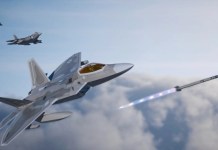Global military analysts have their hopes high on China’s next-generation stealth fighter, which according to reports, aims to challenge or even surpass the American F-35.
The fighter jet, currently under development, exploits the cutting-edge advances in artificial intelligence (AI) by the Chinese and is expected to roll out by 2035.
Experts agree that the superiority of the next-generation fighter jets will be determined by the application of AI in data processing and decision making. The AI is expected to usher in radical changes when it comes to computing, sensing, targeting, maneuvering, and various kinds of attack tactics in combat aircraft.
China’s next-generation stealth fighter will be different in precisely this aspect. If the chief designer of the country’s J-20 is to be believed, China is integrating artificial intelligence capabilities into its next-generation fighter in an unprecedented way.
The state-owned newspaper Global Times quoted the findings of a recent paper by the chief designer of China’s J-20, which startled the military enthusiasts around the world.
“A revolutionary, cognition-subverting next-generation fighter jet, characterized by long-range, high capabilities in penetration, awareness, firepower, and fast decision-making, is about to come into being amid great power competition,” it said.

It noted that artificial intelligence will play a prime role in assisting pilots in processing vast information and making decisions in complicated battlefield environments. There are all indications that to defeat the competition in next-generation stealth jets, China will integrate artificial intelligence in a first-of-its-kind manner.
Yang Wei of Aviation Industry Corporation of China (AVIC), who is also the chief designer of J-20, believes that in older generations of fighter jets, maneuverability used to be the deciding factor, but this concept is becoming outdated with the development of advanced medium-range air-to-air missiles with their beyond-visual-range attack capabilities.
“Information has now become the deciding factor,” he says, adding that “as modern fighter jets focus on gaining more information with the help of AESA radars and data chains, while also reducing opponents’ ability to gain information, including using stealth technology and electronic countermeasures.”
Integration of more equipment and systems into modern aircraft will mean more information, which will require the pilots to have extensive knowledge, sharp analysis, and fast decision-making capacity to make use of that information.
This is where AI comes into play, which will process the information and help the pilots to make fast and credible decisions in an environment where every second matters.
How fast the decisions are made by a pilot is gauged with something called the ‘observe-orient-decide-act (OODA)’ loop, every step of which according to Yang’s paper, will feature AI assistance. China calls it OODA 3.0, claiming it to be faster than the US’s OODA, which could be a decisive factor in a war where “intelligence becomes the deciding factor.”
According to Yang, “a future fighter jet will generally require a longer combat range, longer endurance, stronger stealth capability, a larger load of air-to-air and air-to-surface weapons, and the functionality to provide its pilot with easy-to-understand battlefield situation images and predictions.”
HAL Meets ‘Full-Production Target’ Of 140 Sukhoi Su-30MKI Fighter Jets At Nashik Facility
The paper describes an “integrated system, where the aircraft is able to form a network, draw real-time integrated situational images, create multiple attack routes, and transmit target information across mission areas in real-time.”
The vision outlines what China’s future fighter jet could look like. It could feature laser, adaptive engines, and the ability to command drones, Global Times said, citing Wang Haifeng, another senior designer at AVIC who participated in the development of the J-20 and J-10 fighter jets.
The description given by Global Times of the technical plans of the Chinese next-generation fighter is eerily similar to the American F-35, which features autonomous decision-making tools, using sensor fusion that creates a single integrated picture of the battlefield enhancing awareness, survivability, and lethality.
Latest US F-16 ‘Viper’ Jets Embarrassed In Aerial Dogfight, Loses 5-0 To Opponent
Although no other internal system details are available of the Chinese futuristic jet, any real conclusions cannot be drawn at this point.
However, if the claims being made by the Chinese experts and the media about the aircraft are true, then the jet will be a major challenger to the American fifth-generation fighter, which is currently the most powerful in existence.
With all these features, India too may have to move beyond Rafale as and when its neighbor rolls out its surprise next-generation fighter jet. Despite the presence of advanced weapons like the Meteor BVRAAM, MICA, and the Scalp long-range cruise missiles, the Rafales may not stand a chance against the new Chinese stealth jet, which will have all of these features besides unparalleled stealth capabilities.
Although the Indian Rafales have multiple modern sensors and EW warfare capabilities, confronting an AI-powered futuristic jet with super-stealthy features will be a challenge for the French-made fighter. As the experts say, it’s a battle that has already been lost.
Follow EurAsian Times on Google News




